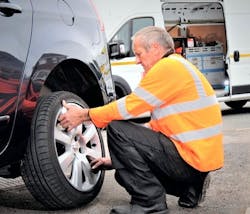Back in this column around two years ago, I reported on the increasing growth in mobile tire installation, or fitment, services throughout all European countries. This momentum continues to gather speed and interest.
Everyday life in Europe is becoming more and more automated and time-related, and the automotive market is no exception.
Since 2017, more and more tire retail outlets in almost every European country have given in to public demand and have introduced their own mobile tire fitting services.
It is now believed that the mobile tire fitment market could account for as much as 10% to 15% of the overall new tire sales in Europe, although it is difficult to get an exact figure as many tire retailers do not segregate the income from sales outside of their tire centers.
What is also interesting about this development is that although at first most mobile tire fitters visited the homes of their customers, the growing trend is to have new tires fitted in the office car park while customers are at work.It is estimated that home fitment still has the slight edge in popularity at 60%, but I can see a time in the not-too-distant future when the ratio will be equal.
I recently surveyed exactly what has led to this potentially huge interest by motorists in having tires replaced outside the traditional retail center, where they waited while the work was carried out. It is very clear the increasingly popular online shopping “lifestyle” has had a major impact, as it is a convenient and time-saving way of buying a product and having it delivered to your door. So despite the need for tires also to be installed after their purchase, tire sales are also going down this modern route.
In this new age of mobile tire fitment services, motorists can shop for replacement tires at their leisure on tire retailers’ websites, then have their choice of brand fitted either at their home or place of work.
It is also interesting to note that the business fleet market is increasingly appreciating the many benefits of mobile tire fitment services, because as an employer with a team of sales representatives on the road, they can have their fleets’ tires checked and replaced where necessary — perhaps while holding their monthly sales meeting, for example.I also have examined how retail dealers feel about this growing new direction in new tire sales.
Let’s not forget that mobile tire service is not a direct competitor or an alternative to more traditional tire and automotive stores, which will still be available to carry out those other, more heavy and complex tire services, such as alignment and outer body repairs.
In fact, the general impression I have received from a number of both multi-national and independent tire dealers is of resounding enthusiasm as they appreciate the fact that there is a very real business potential in having a fleet of tire-fitting vehicles on the road, vehicles that are fully equipped and ready to replace tires at a location of the customer’s choice.
Every day I see mobile tire technicians driving around in their fully equipped vans on their way to assist customers. Of course, as often happens with new concepts, there is a potential downside to this flexible service. In this case, it is tire technicians sometimes placing themselves in danger of being hit and injured by passing vehicles as they work on vehicles. However, new technology to remove this danger is already on its way.
The main challenge I see with mobile tire-fitting vehicles is the amount of equipment they have had to carry onboard. But I have seen for myself that the inside of these vehicles, at least in Europe, is about to change dramatically as a new, revolutionary single unit covering all aspects of tire changing has recently become available. In my opinion, this will — in time — take the idea of having tires changed and replaced to an even greater level of efficiency and popularity. ■
John Stone has been working within the global tire industry for the past 28 years. In 2004 he launched his own consulting company, Sapphire Media Service, which caters to business media clients around the globe. Stone also writes for tire and automotive-related publications in Europe, South Africa and Asia.
About the Author
John Stone
John Stone has been working within the global tire industry for more than 30 years and is the owner of Sapphire Media Service, which caters to business media clients around the globe.
